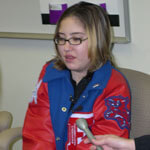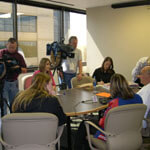
We learn, as children, to show our patriotism whenever the Star-Spangled Banner is played. As we sing of the rockets’ red glare and the flag still there, we hold the right hand over the heart as a sign of allegiance to America. We look down and feel the heart beating in the left side of the chest.
For 19 years Wendy Bailey felt something different. This college student from the Lower Rio Grande Valley was born with unusual anatomy – a heart on the wrong side and consisting of only one receiving chamber and one pumping chamber. In late 2004, as the holidays came and went, her “birth heart” began to give out.
A call from a nearby city brought the organ she desperately needed. In late January, surgeons from Health Science Center and CHRISTUS Transplant Institute removed Wendy’s failing heart and implanted a new donor heart in the correct position in her chest.
“Her heart was located to the right side and backward with a number of strange connections of the veins and arteries,” said John Calhoon, M.D., professor and chief of thoracic surgery at the Health Science Center. “Our team gave her a new heart and did all of the plumbing necessary to put her heart where it belongs – in her left chest. It is a first for us in San Antonio, to my knowledge, and is a very rare kind of transplant.”

Charles Moore, M.D., surgical director of heart transplants and assist devices at the CHRISTUS Transplant Institute, procured the organ. He and Daniel Martinez, M.D., of the Health Science Center, assisted Dr. Calhoon with the transplant.
When Wendy was born 10 weeks premature on Feb. 26, 1986 in McAllen, it was clear she was fighting to breathe. Physicians performed two surgeries in her first year of life to connect the heart, through shunts, to the lung blood vessels to carry more oxygen to her body. It was a technique that saved her life, but her condition required constant monitoring. Much of that responsibility fell to her primary care physician, Oralia Wells, M.D. Dr. Wells, a former resident at the Health Science Center, has cared for Wendy for a number of years.
“The shunts implanted when Wendy was an infant were beautiful surgeries but they weren’t the cure,” Dr. Moore said. “The fact it (the heart) was on the right side required innovations to hook up the new heart correctly.”
The heart expands and contracts to pump oxygenated blood through the arteries. Once the body uses the oxygen, the blood returns to the heart through the veins. Dr. Moore explained that Wendy’s heart was “like a fish heart, where oxygenated and deoxygenated blood mixed together in one chamber.”
Like master plumbers, the surgeons used the donor’s pulmonary artery to reconstruct Wendy’s pulmonary artery. They took another donor blood vessel, the superior vena cava, to reconstruct Wendy’s right superior vena cava and made other vital corrections. Then they placed the donor heart in Wendy’s left chest.
Drs. Calhoon, Moore, Martinez and James Rogers, M.D., clinical professor of pediatric cardiology at the Health Science Center, worked together for months to define the anatomy and surgical approach.
In 2003 the Health Science Center named Dr. Calhoon to the Calhoon President’s Council Chair for Excellence in Surgery. The chair is named in honor of his family, which has produced five outstanding surgeons. He and Dr. Moore are longtime pioneers of pediatric and heart transplants in San Antonio.
For more information on Wendy’s condition, click here:www.uthscsa.edu/HSCNews/archive/HeartRedesign.pdf

